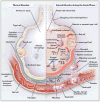Jack of all trades: pleiotropy and the application of chemically modified tetracycline-3 in sepsis and the acute respiratory distress syndrome (ARDS)
- PMID: 21767646
- PMCID: PMC3195907
- DOI: 10.1016/j.phrs.2011.06.012
Jack of all trades: pleiotropy and the application of chemically modified tetracycline-3 in sepsis and the acute respiratory distress syndrome (ARDS)
Abstract
Sepsis is a disease process that has humbled the medical profession for centuries with its resistance to therapy, relentless mortality, and pathophysiologic complexity. Despite 30 years of aggressive, concerted, well-resourced efforts the biomedical community has been unable to reduce the mortality of sepsis from 30%, nor the mortality of septic shock from greater than 50%. In the last decade only one new drug for sepsis has been brought to the market, drotrecogin alfa-activated (Xigris™), and the success of this drug has been limited by patient safety issues. Clearly a new agent is desperately needed. The advent of recombinant human immune modulators held promise but the outcomes of clinical trials using biologics that target single immune mediators have been disappointing. The complex pathophysiology of the systemic inflammatory response syndrome (SIRS) is self-amplifying and redundant at multiple levels. In this review we argue that perhaps pharmacologic therapy for sepsis will only be successful if it addresses this pathophysiologic complexity; the drug would have to be pleiotropic, working on many components of the inflammatory cascade at once. In this context, therapy that targets any single inflammatory mediator will not adequately address the complexity of SIRS. We propose that chemically modified tetracycline-3, CMT-3 (or COL-3), a non-antimicrobial modified tetracycline with pleiotropic anti-inflammatory properties, is an excellent agent for the management of sepsis and its associated complication of the acute respiratory distress syndrome (ARDS). The purpose of this review is threefold: (1) to examine the shortcomings of current approaches to treatment of sepsis and ARDS in light of their pathophysiology, (2) to explore the application of COL-3 in ARDS and sepsis, and finally (3) to elucidate the mechanisms of COL-3 that may have potential therapeutic benefit in ARDS and sepsis.
Copyright © 2011 Elsevier Ltd. All rights reserved.
Figures









Similar articles
-
Chemically modified tetracycline prevents the development of septic shock and acute respiratory distress syndrome in a clinically applicable porcine model.Shock. 2005 Oct;24(4):348-56. doi: 10.1097/01.shk.0000180619.06317.2c. Shock. 2005. PMID: 16205320
-
Chemically modified tetracycline 3 prevents acute respiratory distress syndrome in a porcine model of sepsis + ischemia/reperfusion-induced lung injury.Shock. 2012 Apr;37(4):424-32. doi: 10.1097/SHK.0b013e318245f2f9. Shock. 2012. PMID: 22258231
-
Matrix metalloproteinase inhibitor properties of tetracyclines: therapeutic potential in cardiovascular diseases.Pharmacol Res. 2011 Dec;64(6):551-60. doi: 10.1016/j.phrs.2011.05.005. Epub 2011 May 31. Pharmacol Res. 2011. PMID: 21689755 Review.
-
Inhibition of matrix metalloproteinases by chemically modified tetracyclines in sepsis.Shock. 2003 Sep;20(3):280-5. doi: 10.1097/00024382-200309000-00014. Shock. 2003. PMID: 12923502
-
The Role of MicroRNAs in Acute Respiratory Distress Syndrome and Sepsis, From Targets to Therapies: A Narrative Review.Anesth Analg. 2020 Nov;131(5):1471-1484. doi: 10.1213/ANE.0000000000005146. Anesth Analg. 2020. PMID: 33079870 Free PMC article. Review.
Cited by
-
Biotic acts of antibiotics.Front Microbiol. 2013 Aug 19;4:241. doi: 10.3389/fmicb.2013.00241. eCollection 2013. Front Microbiol. 2013. PMID: 23966991 Free PMC article.
-
Impact of chemically-modified tetracycline 3 on intertwined physiological, biochemical, and inflammatory networks in porcine sepsis/ARDS.Int J Burns Trauma. 2015 Mar 20;5(1):22-35. eCollection 2015. Int J Burns Trauma. 2015. PMID: 26064799 Free PMC article.
-
High expression of long non-coding RNA MALAT1 correlates with raised acute respiratory distress syndrome risk, disease severity, and increased mortality in sepstic patients.Int J Clin Exp Pathol. 2019 May 1;12(5):1877-1887. eCollection 2019. Int J Clin Exp Pathol. 2019. PMID: 31934011 Free PMC article.
-
Non-antibacterial tetracycline formulations: host-modulators in the treatment of periodontitis and relevant systemic diseases.Int Dent J. 2016 Jun;66(3):127-35. doi: 10.1111/idj.12221. Epub 2016 Mar 23. Int Dent J. 2016. PMID: 27009489 Free PMC article. Review.
-
Chemically modified tetracyclines: Novel therapeutic agents in the management of chronic periodontitis.Indian J Pharmacol. 2012 Mar;44(2):161-7. doi: 10.4103/0253-7613.93841. Indian J Pharmacol. 2012. PMID: 22529468 Free PMC article.
References
-
- Machiavelli N. Bantam Classics. Vol. 1515. Bantam: The Prince; p. 166.
-
- Moore LJ, et al. Sepsis in general surgery: the 2005–2007 national surgical quality improvement program perspective. Arch Surg. 145(7):695–700. - PubMed
-
- Moore LJ, et al. Sepsis in general surgery: a deadly complication. Am J Surg. 2009;198(6):868–74. - PubMed
-
- Barie PS, et al. Benefit/risk profile of drotrecogin alfa (activated) in surgical patients with severe sepsis. Am J Surg. 2004;188(3):212–20. - PubMed
Publication types
MeSH terms
Substances
Grants and funding
LinkOut - more resources
Full Text Sources
Medical

